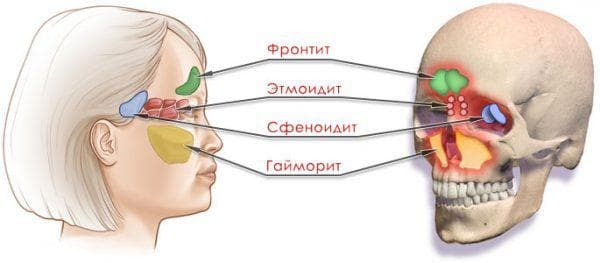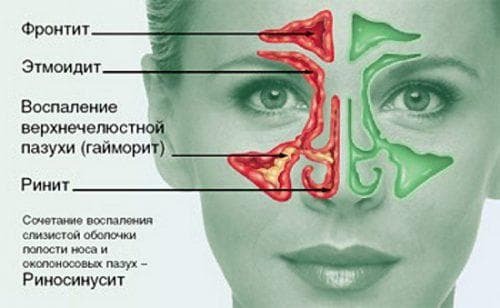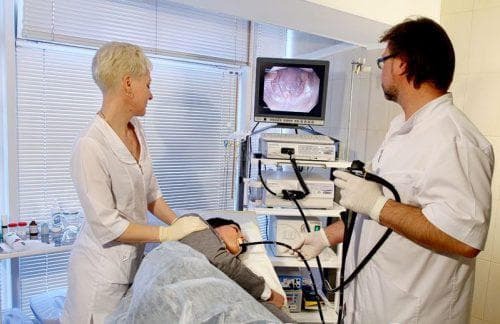
Etomoiditis is a pathology that consists in the defeat of the inflammatory process of the mucous membrane located near the latticed bone. It is located between the nasal cavity and the cavity of the skull. It consists of bony cells, which are lined with ciliary epithelium. There is a pathology in two forms - acute and chronic. Each of them has its own symptoms and therapy.
Contents
- 1 How to recognize an acute form
- 2 How to recognize a chronic form
- 3 Risk factors
How to recognize an acute form
Acute ethmoiditis is accompanied by severe symptoms. Due to this, it is possible to recognize the disease in time and start to treat it in time, and also to prevent the development of a chronic form of pathology. The main signs of ethmoiditis of acute course include weight at the base of the nose, nasal congestion and discharge, having a yellow-green color and pus. In addition, the patient is visited by severe headaches.

On the photo-acute form of the ethmoidite
For acute etmoiditis, a rise in temperature, deterioration in general condition, fatigue and weakness is characteristic. Pain syndrome focuses in the root of the nose and in the eye sockets. The intensity of pain is determined by taking into account the irritation of the nerve roots of the trigeminal nerve, which pass in the affected lattice brush.
Skin covers on the inner part of the orbit and at the base of the nose are thickened, and when they are touched, the is sensed. There are pains in the head that pulsate into the forehead, nose and eyes. Pain pain intensifies at night. But during the day there is a rapid fatigue when working at the computer.
In the category of people who have weak immunity, partial destruction of the bone walls occurs. Inflammatory process affects the soft tissues of the inner corner of the orbit.
The pathological process can spread to neighboring tissues and lead to the formation of numerous foci. This leads to vtutnichraypnye and orbital consequences, osteomyelitis of the upper jaw. Thus, the lesion affects the bronchopulmonary system. In the orbit there is an abscess formation.
This abscess is accompanied by painful sensations, especially when moving with the eyes. This condition worsens vision and leads to swelling of the eyelids. The eyeball is shifted outward, and the pain syndrome in the orbit is intense.
For acute course of ethmoiditis, discharge from the nose is also characteristic. They can contain pus and blood. Even after the release of new moves, the nasal congestion still remains. With constant irritation, the patient sneezes all the time. Often the function of smell is disturbed.

On the photo - discharge from the nose
Puffiness affects the area of the lacrimal sac, redness of the inner corners of the eyes is observed, and when palpation of the tear bone, which is concentrated at the root of the nose, there is a strong pain. Symptoms of acute etmoiditis in small patients are in poor appetite and vomiting. In children, the process is much more acute than in adults. And this is explained by the fact that the children's organism has low immunity and is unable to correct the pathogens of the infectious process.
How to recognize the chronic form of
Chronic etmititis is the result of an untreated rhinitis. In addition, the birth defects of the nasal cavity can affect the development of the chronic process. This form of the disease is considered very dangerous, since its symptoms are hidden. Because of this, it is not possible to start therapy in time, which leads to the development of complications. Detect the symptoms of chronic etmoiditis are felt after 2 months after the acute form. In addition, the transition of the disease to a chronic form is influenced by polyps. They block the normal outflow of mucus, resulting in an optimal environment for the development and life of microorganisms.

On the photo - chronic etmoiditis
The general state of health of the patient worsens, he quickly gets tired, becomes irritable, his work capacity goes down. Very often, the chronic course of ethmoiditis persists for a long time, and its symptoms are of a sluggish character. Between exacerbations the patient's condition improves and he feels full.
 Which cough lozenges during pregnancy are the best and how they are called, is described in this article.
Which cough lozenges during pregnancy are the best and how they are called, is described in this article.
But what are the symptoms of sinusitis of the nose are found most often and what medicine is the best, is detailed in this article.
It will also be interesting to learn about what can be from the common cold in pregnancy: http: //prolor.ru/n/ lechenie-n / lechim-nasmork-pri-beremennosti-narodnye-sredstva.html
But is it dangerous if angina is in pregnancy and what medicines will help in thisproblem, is described in great detail in this article.
If the stage of exacerbation is observed, it is characterized by the following symptoms:
- discharge from the nose of a purulent nature;
- pus and mucus flows down the wall of the nasopharynx, in large numbers it is released in the morning, sometimes it is even difficult for the patient to expectorate;
- pain in the nose, which, when the head is tilted, is worse;
- headache;
- edema of the upper eyelid;
- pain in gases when moving the eyeballs.
If there is swelling from the area of the eyelid and pain in the right eye socket, then these are the symptoms of right-sided etmoiditis. If there is severe symptomatology on the left side, then this is left-side ethmoiditis. When all the cells of the latticed bone are implanted in the pathological process, the pathologists take a two-sided nature.
With the help of endoscopic diagnostics at the stage of chronic disease, it is possible to detect a pronounced thickening of the mucosa. Scientifically this process is called hyperplastic etmoiditis. This form of the disease is characterized by the growth of the mucosa of the middle shell of the nose. At the same time it grows so strong that it closes with the nasal septum.

On photo-endoscopic diagnosis
Malfunction of the mucosa promotes the formation of polyps. Prolonged swelling and inflammatory process lead to polyposis. This phenomenon, which is characterized by numerous lesions of the nasal cavity polyps. They arise in such quantity, they completely block the nasal cavity and come out. This form of pathology is called polyposic etmoiditis. Here there is deformation of the nasal septum.
Which nasal spray from sinusitis is the most effective, and what is their name, will help to understand this information.
Than to treat a problem when pershit in a throat at pregnancy, and what medicines the most effective, will help or assist to understand the given information.
And here's how to get rid of stuffy nose folk remedies, and which of them are the most effective, is indicated in this article.
Whether it is possible to warm a nose at a genyantritis, and how it to do or make correctly, is in detail told in this article.
What are the best drops in the nose for allergic rhinitis, and what is their name, is detailed in the article.
Risk Factors
Etomoiditis is an inflammatory disease, therefore it can not arise by itself. Influences on the development of inflammation can be bacteria viruses that penetrate the body of a child or an adult.
The presented pathology can develop against the background of the following pathologies:
- ARVI, influenza, rubella in small patients;

In the photo-signs of acute respiratory viral infection in adults
- bacterial infections - angina, scarlet fever, otitis, purulent rhinitis;
- is already present etmoidit other localization.
Etomoiditis is a pathological process that causes a lot of inconvenience to a person. Against its background, various complications may develop, including deterioration of sight and smell. Treat the pathology immediately after the discovery of the first symptoms. This is the only way to avoid the transition of the acute form into a chronic one, which is difficult to treat.
